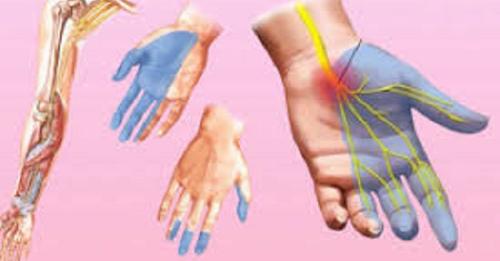A common feature that most people with fibromyalgia presents is a diffuse pain that affects a large part of the body. This disconcerting symptom is often accompanied by morning stiffness, numbness in the hands and feet, ie tingling and numbness, sleep disturbances and above all a feeling of fatigue and fatigue that accompanies them throughout the day. This fatigue contributes to the fact that fibromyalgia has little effort tolerance that affects up to 90% of the patients. That is why a study carried out by a team from the University of Granada,…
Read MoreWhat Does Hand Pain And Fibromyalgia Feel Like?
Hand Pain And Fibromyalgia Do you have hand pain and fibromyalgia?Pain in the extremities is common in fibromyalgia and sometimes overlooked due to the other common pain areas of the fibro body. It might be hard to distinguish the difference between pain that is caused from fibromyalgia, nerve pain or pain that stems from another condition like any of the various types of arthritis. The hand pain might be coming from another condition, but in the interest of hand pain and fibromyalgia and the many questions that arise, we will focus on…
Read MoreTemperature Dysregulationand Fibromyalgia
Do you feel like your internal thermostat is broken? You are certainly not alone. Temperature dysregulation is quite common in fibromyalgia. And yet, as warm-blooded animals, human beings are usually quite amazing. When our surrounding environment heats up, our bodies are supposed to automatically kick into gear to cool things down internally. What happens when the surrounding environment gets chilly? Our bodies know just how to warm things up. With fibromyalgia, we are susceptible to an additional factor called Adrenaline Dominance. When adrenaline is too high for extended periods of…
Read MoreHow can we protect Bone Density when livingwith Fibromyalgia?
Protecting and improving our bone density is crucial as we agewith Fibromyalgia. The GOOD news is that our approach for protecting bone density and muscular strength is well verified for those of us with fibromyalgia and other conditions like Rheumatoid Arthritis and Auto Immune. Fibromyalgia and Bone Density Maintaining strong bones is crucial for women over 50 due to the increased risk of osteoporosis and fractures.First, what is Bone Density? Bone density refers to the amount of bone mineral in bone tissue, which indicates the strength of bones. Peak bone…
Read MoreWhat is Fibromyalgia? – Symptoms & Treatment
Overview of Fibromyalgia Fibromyalgia is a chronic (long-lasting) disorder that causes pain and tenderness throughout the body, as well as fatigue and trouble sleeping. Scientists do not fully understand what causes it, but people with the disorder have a heightened sensitivity to pain. There is no cure for fibromyalgia, but doctors and other health care providers can help manage and treat the symptoms. Treatment typically involves a combination of exercise or other movement therapies, psychological and behavioral therapy, and medications. Who Gets Fibromyalgia? Anyone can get fibromyalgia, but more women…
Read MoreFibromyalgia flares: Warning signs, tips, and treatments
How to recognize fibromyalgia flares and what to do about them Fibromyalgia is a long-term condition that causes pain and tenderness throughout the body. Symptoms of fibromyalgia flares vary but often involve widespread pain, joint stiffness, and extreme sensitivity to stimuli. Some people with fibromyalgia may experience certain symptoms regularly. However, the pain associated with fibromyalgia tends to fluctuate and worsen. When symptoms temporarily increase in number or intensity, it is called a flare or flare-up. A flare-up can last anywhere from a few days to weeks. When fibromyalgia pains…
Read More8 FIBROMYALGIA SYMPTOMS YOU SHOULD KNOW
Fibromyalgia, commonly referred to as “fibro,” is a painful condition that increases the body’s sensitivity to sensation, causing pain. Because this condition cannot be diagnosed by traditional tests, it can sometimes be difficult for patients to receive a definitive diagnosis. Doctors rely on the presence of symptoms to determine if the patient may have fibromyalgia. If you experience pain and tenderness on a regular basis, but can’t explain it, it is possible you may have fibromyalgia. Your doctor can discuss your symptoms with you and investigate other causes or potential treatments…
Read More4 Stages of Fibromyalgia: A Comprehensive Guide
Understanding the 4 Stages of Fibromyalgia Fibromyalgia, a chronic disorder characterized by widespread musculoskeletal pain, fatigue, and tender points in localized areas, affects millions globally. The journey of living with this condition is commonly divided into 4 stages of fibromyalgia. This blog aims to provide an in-depth understanding of these stages, the transitions between them, and the ways patients can manage their symptoms throughout each phase. Introduction to Fibromyalgia Before delving into the fibromyalgia stages, it’s crucial to understand the condition itself. Fibromyalgia is a long-term, chronic disorder often characterized…
Read MoreWhat is Duloxetine Hcl: Uses, Warnings & Interactions
Duloxetine Hcl overview BRAND NAMES: GENERIC NAMES: USES: THERAPEUTIC CLASSES: FORMS: HOW IT’S TAKEN: What is Duloxetine Hcl used for? The FDA has approved duloxetine as a treatment for major depressive disorder and generalized anxiety disorder. As a nerve pain agent, duloxetine is also used to treat nerve pain as a result of diabetic nerve damage, chronic bone and muscle pain such as back pain, and fibromyalgia. What form(s) does Duloxetine Hcl come in What are common Duloxetine Hcl doses? Common Duloxetine Hcl prescriptions How to take Duloxetine Hcl What…
Read MoreIf you love someone with fibromyalgia, keep in mind that they suffer from severe pain that varies from day to day and hour to hour.
If you love someone with fibromyalgia experience severe pain that varies from day to day and from hour to hour. We can not predict that. So we want you to understand that sometimes things have to be canceled at the last minute and it bothers us as much as you. We want you to know that we must learn to accept our body with its limits, and it is not easy. There is no cure for fibromyalgia, but we try to relieve the symptoms every day. We ask not to suffer from this. Many…
Read More

















